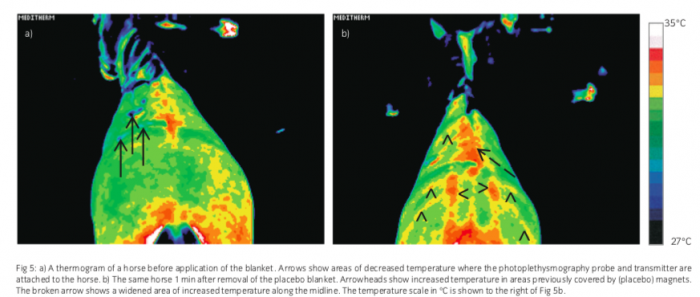
The effect of magnetic blankets on horses
Recently, the number of magnetic blankets and commercial promotions for use in horses has increased dramatically. The manufacturers claim that it can be used for prevention of diseases and to treat muscle soreness and delayed wound healing. It also claims to decrease pain, because it should increase blood flow and this has also a calming effect.
The effects of magnets are widely investigated on human and animals, however the effects are conflicting. No previous study investigated the effect of static magnets on the back of the horse. Therefor the aim of these Swedish researchers was to investigate the possible clinical effects of static magnets on back muscles in healthy horses by assessing muscle blood flow, skin temperature, mechanical nociceptive thresholds and behaviour.
Ten healthy horses were assessed two hours after the magnetic therapy- or placebo blankets were placed on them. The most common method to assess muscle tenderness and pain is manual palpation. However, it is difficult to objectify these outcomes. With the pressure algometry mechanical nociceptive thresholds can be measured. These outcomes of these are lower for horses who are in pain.
The results of the different tests were:
- Blood flow No statistical differences within groups were found over time, and there was great individual variation in response to application of either blanket.
- Ambient and local skin temperature measurements In both groups, skin temperature was significantly increased at all time points during treatment.
- Thermography With subjective assessment, a clear pattern showing areas of increased temperature coinciding with the placement of magnets (‘magnet-pattern’) was recognised in 4 thermograms.Three of these thermograms were from horses wearing the placebo blanket.
- Pressure algometry There were no significant differences in mechanical nociceptive thresholds between the 3 soft tissue locations, nor between or within groups for any of the measurement locations.
- Behaviour There were no significant differences in behavioural traits between treatments.
- Magnetism The measured magnitude of magnetism at the level of the skin of 3 horses, directly underneath an active magnet, varied between 20–250 gauss. 900 gauss was never reached.
In conclusion, static magnetic blankets did not have significant effects on muscle blood flow, skin temperature, MNTs of the epaxial muscles and behaviour as compared with a placebo blanket in healthy horses. Further research is needed to investigate if any effect may exist for horses with a painful condition.
Expert opinion by Marly Coppens
Because of the study design used (experimental and basic research), the results can only indicate that there are no effects of magnetic blankets on this small study group of healthy horses and on these parameters; muscle blood flow, skin temperature, mechanical nociceptive thresholds and behaviour. This may be against your own experiences on horses in pain or horses with behavioural problems. In my opinion this research throws a critical note towards magnetic blankets and gives us the oppurtunity to sit back and reflect on what commercials may want us to believe.
> From: Edner et al., Equine Vet J 47 (2015) 302–307 . All rights reserved to EVJ Ltd.. Click here for the online summary.


